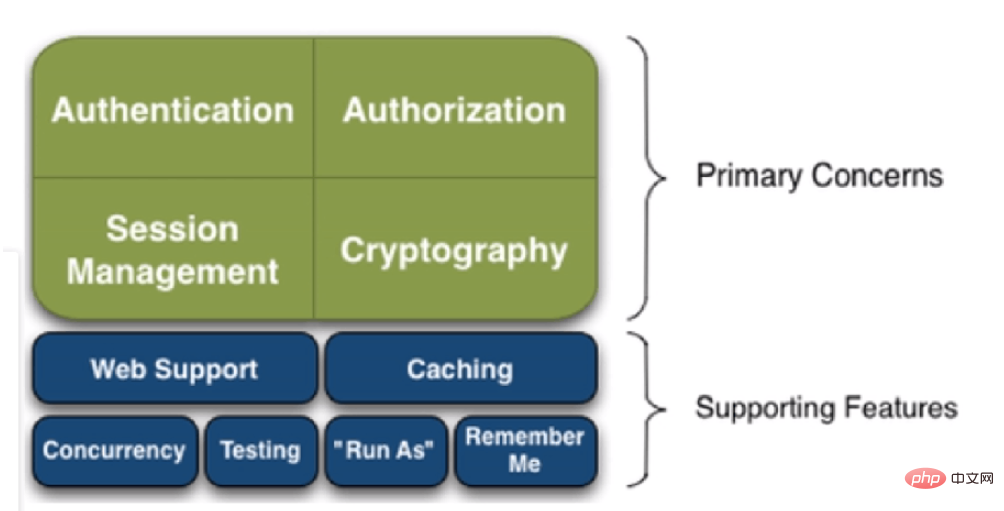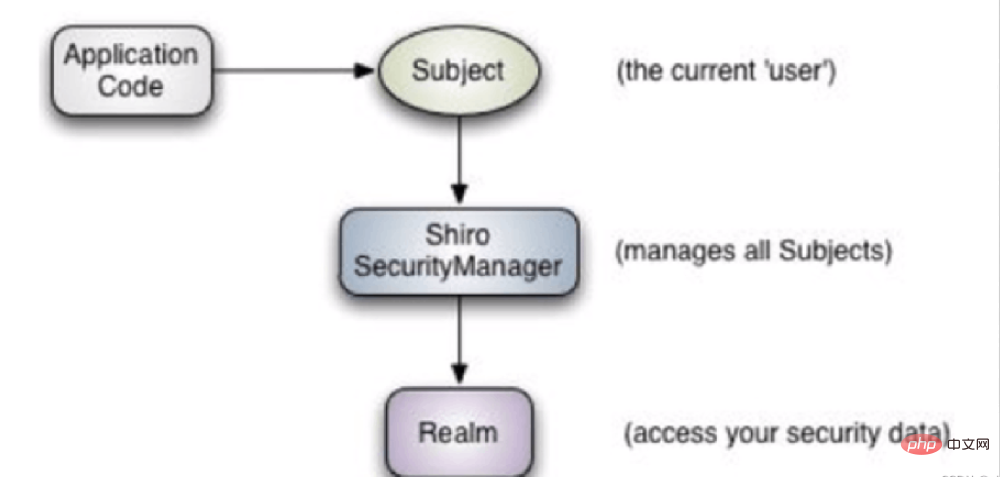
まずは hiro とは何かということを広めていきましょう hiro の元々の名前は Apachehiro で、Java のセキュリティ (権限) フレームワークです。 Shiro を使用すると、JavaSE 環境だけでなく JavaEE 環境でも使用できる適切なアプリケーションを非常に簡単に開発できます。 Shiro は、認証、承認、暗号化、セッション管理、Web 統合、キャッシュ、その他の高度なアプリケーションを実行できます。次の図に示すように、hiro の機能とアーキテクチャの図を参照してください。


これ以上苦労することなく、Springboot は hiro を統合します。直接行きましょう。コード
pom.xmlファイル
<?xml version="1.0" encoding="UTF-8"?>
<project xmlns="http://maven.apache.org/POM/4.0.0" xmlns:xsi="http://www.w3.org/2001/XMLSchema-instance"
xsi:schemaLocation="http://maven.apache.org/POM/4.0.0 https://maven.apache.org/xsd/maven-4.0.0.xsd">
<modelVersion>4.0.0</modelVersion>
<parent>
<groupId>org.springframework.boot</groupId>
<artifactId>spring-boot-starter-parent</artifactId>
<version>2.6.11</version>
<relativePath/> <!-- lookup parent from repository -->
</parent>
<groupId>com.example</groupId>
<artifactId>demo02</artifactId>
<version>0.0.1-SNAPSHOT</version>
<name>demo02</name>
<description>demo02</description>
<properties>
<java.version>1.8</java.version>
</properties>
<dependencies>
<dependency>
<groupId>org.apache.shiro</groupId>
<artifactId>shiro-spring</artifactId>
<version>1.4.1</version>
</dependency>
<dependency>
<groupId>org.mybatis.spring.boot</groupId>
<artifactId>mybatis-spring-boot-starter</artifactId>
<version>2.1.0</version>
</dependency>
<dependency>
<groupId>mysql</groupId>
<artifactId>mysql-connector-java</artifactId>
<version>8.0.31</version>
</dependency>
<!-- https://mvnrepository.com/artifact/log4j/log4j -->
<dependency>
<groupId>log4j</groupId>
<artifactId>log4j</artifactId>
<version>1.2.17</version>
</dependency>
<!-- https://mvnrepository.com/artifact/com.alibaba/druid -->
<dependency>
<groupId>com.alibaba</groupId>
<artifactId>druid</artifactId>
<version>1.1.12</version>
</dependency>
<dependency>
<groupId>org.projectlombok</groupId>
<artifactId>lombok</artifactId>
<version>1.18.18</version>
<scope>compile</scope>
</dependency>
<dependency>
<groupId>org.springframework.boot</groupId>
<artifactId>spring-boot-starter-thymeleaf</artifactId>
</dependency>
<dependency>
<groupId>org.thymeleaf</groupId>
<artifactId>thymeleaf</artifactId>
</dependency>
<dependency>
<groupId>org.thymeleaf.extras</groupId>
<artifactId>thymeleaf-extras-java8time</artifactId>
</dependency>
<dependency>
<groupId>org.springframework.boot</groupId>
<artifactId>spring-boot-starter-web</artifactId>
</dependency>
<dependency>
<groupId>org.springframework.boot</groupId>
<artifactId>spring-boot-starter-test</artifactId>
<scope>test</scope>
</dependency>
<dependency>
<groupId>com.github.theborakompanioni</groupId>
<artifactId>thymeleaf-extras-shiro</artifactId>
<version>2.0.0</version>
</dependency>
</dependencies>
<build>
<plugins>
<plugin>
<groupId>org.apache.maven.plugins</groupId>
<artifactId>maven-compiler-plugin</artifactId>
<version>3.8.1</version>
<configuration>
<source>1.8</source>
<target>1.8</target>
<encoding>UTF-8</encoding>
</configuration>
</plugin>
<plugin>
<groupId>org.springframework.boot</groupId>
<artifactId>spring-boot-maven-plugin</artifactId>
</plugin>
</plugins>
</build>
</project>次にデータベースを作成します /*
Navicat MySQL Data Transfer
ソースサーバー:
ソースサーバーのバージョン: 80030
ソースホスト: localhost:3306
ソースデータベース: mybatis
ターゲットサーバーの種類: MYSQL
ターゲットサーバーのバージョン: 80030
ファイルエンコーディング: 65001
日付 : 2023-03-14 18:00:05
*/
SET FOREIGN_KEY_CHECKS=0;
– ユーザーのテーブル構造
存在する場合はテーブルを削除 user;
CREATE TABLE user (id int NOT NULL AUTO_INCREMENT,name varchar(255) デフォルト NULL、pwd varchar(255) デフォルト NULL、perms varchar(100) デフォルト NULL、
主キー ( id)
) ENGINE=InnoDB AUTO_INCREMENT=4 DEFAULT CHARSET=utf8mb4 COLLATE=utf8mb4_0900_ai_ci;
– user
INSERT INTO user VALUES のレコード(‘1’ , ‘qin’, ‘d1b129656359e35e95ebd56a63d7b9e0’, ‘user:add’);
INSERT INTO user VALUES (‘2’, ‘hai’, ‘ 123’, &ls; user:insert’);
INSERT INTO user VALUES (‘3’, ‘root’, ‘d1b129656359e35e95ebd56a63d7b9e0’, ‘user:update’);
アプリケーション .yml ファイル
spring:
datasource:
username: xxxx
password: xxxxxxxxxxxx
url: jdbc:mysql://localhost:3306/mybatis
driver-class-name: com.mysql.cj.jdbc.Driver
type: com.alibaba.druid.pool.DruidDataSource
mybatis:
mapper-locations: classpath:mapper/*tat.slowSqlMillis=500コントローラー層 MyController クラス
package com.example.demo02.controller;
import lombok.extern.slf4j.Slf4j;
import org.apache.shiro.SecurityUtils;
import org.apache.shiro.authc.IncorrectCredentialsException;
import org.apache.shiro.authc.UnknownAccountException;
import org.apache.shiro.authc.UsernamePasswordToken;
import org.apache.shiro.subject.Subject;
import org.springframework.stereotype.Controller;
import org.springframework.ui.Model;
import org.springframework.web.bind.annotation.RequestMapping;
import org.springframework.web.bind.annotation.RequestParam;
import org.springframework.web.bind.annotation.ResponseBody;
@Controller
@Slf4j
public class MyController {
@RequestMapping("/")
public String toIndex(Model model){
model.addAttribute("msg","hello,shiro");
return "login";
}
@RequestMapping("/user/add")
public String add(){
return "user/add";
}
@RequestMapping("/user/update")
public String update(){
return "user/update";
}
@RequestMapping("/toLogin")
public String toLogin(){
return "login";
}
@RequestMapping("/noauth")
@ResponseBody
public String noAuth(){
return "未经授权不能访问此页面";
}
//登录操作
@RequestMapping("/login")
public String login(String username, String password, @RequestParam(defaultValue = "false")boolean rememberMe,Model model){
//使用shiro,编写认证操作
//1. 获取Subject
Subject subject = SecurityUtils.getSubject();
//2. 封装用户的数据
UsernamePasswordToken token = new UsernamePasswordToken(username, password,rememberMe);
//3. 执行登录的方法,只要没有异常就代表登录成功!
try {
subject.login(token); //登录成功!返回首页
System.out.println("输出认证成功跳转页面");
return "index";
} catch (UnknownAccountException e) { //用户名不存在
model.addAttribute("msg","用户名不存在");
return "login";
} catch (IncorrectCredentialsException e) { //密码错误
model.addAttribute("msg","密码错误");
return "login";
}
}
}pojo 層User
package com.example.demo02.pojo;
import lombok.AllArgsConstructor;
import lombok.Data;
import lombok.NoArgsConstructor;
@Data
@AllArgsConstructor
@NoArgsConstructor
public class User {
private int id;
private String name;
private String pwd;
private String perms;
}config 層設定 2 つのクラス
最初のクラス ShiroConfig
package com.example.demo02.config;
import at.pollux.thymeleaf.shiro.dialect.ShiroDialect;
import org.apache.shiro.authc.credential.HashedCredentialsMatcher;
import org.apache.shiro.spring.web.ShiroFilterFactoryBean;
import org.apache.shiro.web.mgt.DefaultWebSecurityManager;
import org.springframework.beans.factory.annotation.Qualifier;
import org.springframework.context.annotation.Bean;
import org.springframework.context.annotation.Configuration;
import java.util.LinkedHashMap;
import java.util.Map;
//声明为配置类
@Configuration
public class ShiroConfig {
//创建 ShiroFilterFactoryBean
@Bean
public ShiroFilterFactoryBean
getShiroFilterFactoryBean(@Qualifier("securityManager")DefaultWebSecurityManager securityManager){
ShiroFilterFactoryBean shiroFilterFactoryBean = new ShiroFilterFactoryBean();
//设置安全管理器
shiroFilterFactoryBean.setSecurityManager(securityManager);
/*
添加Shiro内置过滤器,常用的有如下过滤器:
anon: 无需认证就可以访问
authc: 必须认证才可以访问
user: 如果使用了记住我功能就可以直接访问
perms: 拥有某个资源权限才可以访问
role: 拥有某个角色权限才可以访问
*
/
*/
//进行一个拦截
Map<String,String> filterMap = new LinkedHashMap<String, String>();
// filterMap.put("/user/add","authc");
// filterMap.put("/user/update","authc");
//授权
// filterMap.put("/user/add","perms[user:add]"); //大家记得注意顺序!
filterMap.put("/user/add","perms[user:add]");
filterMap.put("/user/update","perms[user:update]");
filterMap.put("/user/*","authc");
shiroFilterFactoryBean.setFilterChainDefinitionMap(filterMap);
shiroFilterFactoryBean.setLoginUrl("/toLogin");
//未授权页面
shiroFilterFactoryBean.setUnauthorizedUrl("/noauth");
return shiroFilterFactoryBean;
}
//创建 DefaultWebSecurityManager
@Bean(name = "securityManager")
public DefaultWebSecurityManager
getDefaultWebSecurityManager(@Qualifier("userRealm")UserRealm userRealm){
DefaultWebSecurityManager securityManager = new DefaultWebSecurityManager();
//2创建加密对象,设置相关属性
HashedCredentialsMatcher matcher = new HashedCredentialsMatcher();
//2.1采用md5加密
matcher.setHashAlgorithmName("md5");
//2.2迭代加密次数
matcher.setHashIterations(3);
//3将加密对象存储到myRealm中
userRealm.setCredentialsMatcher(matcher);
//关联Realm
securityManager.setRealm(userRealm);
return securityManager;
}
//创建 realm 对象
@Bean
public UserRealm userRealm(){
return new UserRealm();
}
//配置ShiroDialect:方言,用于 thymeleaf 和 shiro 标签配合使用
@Bean
public ShiroDialect getShiroDialect(){
return new ShiroDialect();
}
}UserRealm
package com.example.demo02.config;
import com.example.demo02.pojo.User;
import com.example.demo02.service.UserService;
import org.apache.shiro.SecurityUtils;
import org.apache.shiro.authc.*;
import org.apache.shiro.authz.AuthorizationInfo;
import org.apache.shiro.authz.SimpleAuthorizationInfo;
import org.apache.shiro.realm.AuthorizingRealm;
import org.apache.shiro.subject.PrincipalCollection;
import org.apache.shiro.subject.Subject;
import org.apache.shiro.util.ByteSource;
import org.springframework.beans.factory.annotation.Autowired;
import java.util.List;
//自定义得UserRaelm
public class UserRealm extends AuthorizingRealm {
@Autowired
UserService userService;
//授权
@Override
protected AuthorizationInfo doGetAuthorizationInfo(PrincipalCollection principalCollection) {
System.out.println("执行了=》授权doGetAuthorizationInfo");
SimpleAuthorizationInfo info=new SimpleAuthorizationInfo();
// info.addStringPermission("user:update");
info.addStringPermission("user:add");
//拿到当前用户登陆对象
Subject subject= SecurityUtils.getSubject();
User currentUser= (User) subject.getPrincipal();//拿到User对象
info.addStringPermission(currentUser.getPerms());//设置当前用户对象
return info;
}
//执行认证逻辑
@Override
protected AuthenticationInfo doGetAuthenticationInfo(AuthenticationToken token) throws AuthenticationException {
System.out.println("执行了=>认证逻辑AuthenticationToken");
//假设数据库的用户名和密码
// String name = "root";
// String password = "123456";
//1.判断用户名
UsernamePasswordToken userToken = (UsernamePasswordToken)token;
//连接真实的数据库
User user= userService.queryUserByName(userToken.getUsername());
//
if(user==null){
return null;
}
Subject subject = SecurityUtils.getSubject();
subject.getSession().setAttribute("loginUser",user);
//2. 验证密码,我们可以使用一个AuthenticationInfo实现类SimpleAuthenticationInfo
// shiro会自动帮我们验证!重点是第二个参数就是要验证的密码!
return new SimpleAuthenticationInfo(user, user.getPwd(),ByteSource.Util.bytes("salt"),"");
// if(user !=null){
// AuthenticationInfo info = new SimpleAuthenticationInfo(
// token.getPrincipal(),
// user.getPwd(),
// ByteSource.Util.bytes("salt"),
// token.getPrincipal().toString()
// );
// return info;
// }
// return null;
}
}サービス層
最初にクラスUserServiceImpl
package com.example.demo02.service;
import com.example.demo02.mapper.UserMapper;
import com.example.demo02.pojo.User;
import org.springframework.beans.factory.annotation.Autowired;
import org.springframework.stereotype.Service;
@Service
public class UserServiceImpl implements UserService {
@Autowired
UserMapper userMapper;
@Override
public User queryUserByName(String name) {
return userMapper.queryUserByName(name);
}
}次にインターフェースUserService
package com.example.demo02.service;
import com.example.demo02.pojo.User;
public interface UserService {
public User queryUserByName(String name);
}マッパー層
インターフェースUsermapper
package com.example.demo02.mapper;
import com.example.demo02.pojo.User;
import org.apache.ibatis.annotations.Mapper;
import org.apache.ibatis.annotations.Param;
import org.apache.ibatis.annotations.Select;
import org.springframework.stereotype.Repository;
@Repository
//@Mapper
public interface UserMapper {
@Select("select * from user where name=#{name}")
public User queryUserByName(@Param("name") String name);
} 次に、フロントエンド リソースには静的リソースとテンプレートがあります。


以上がSpringboot を使用して hiro セキュリティ フレームワークを迅速に統合する方法の詳細内容です。詳細については、PHP 中国語 Web サイトの他の関連記事を参照してください。